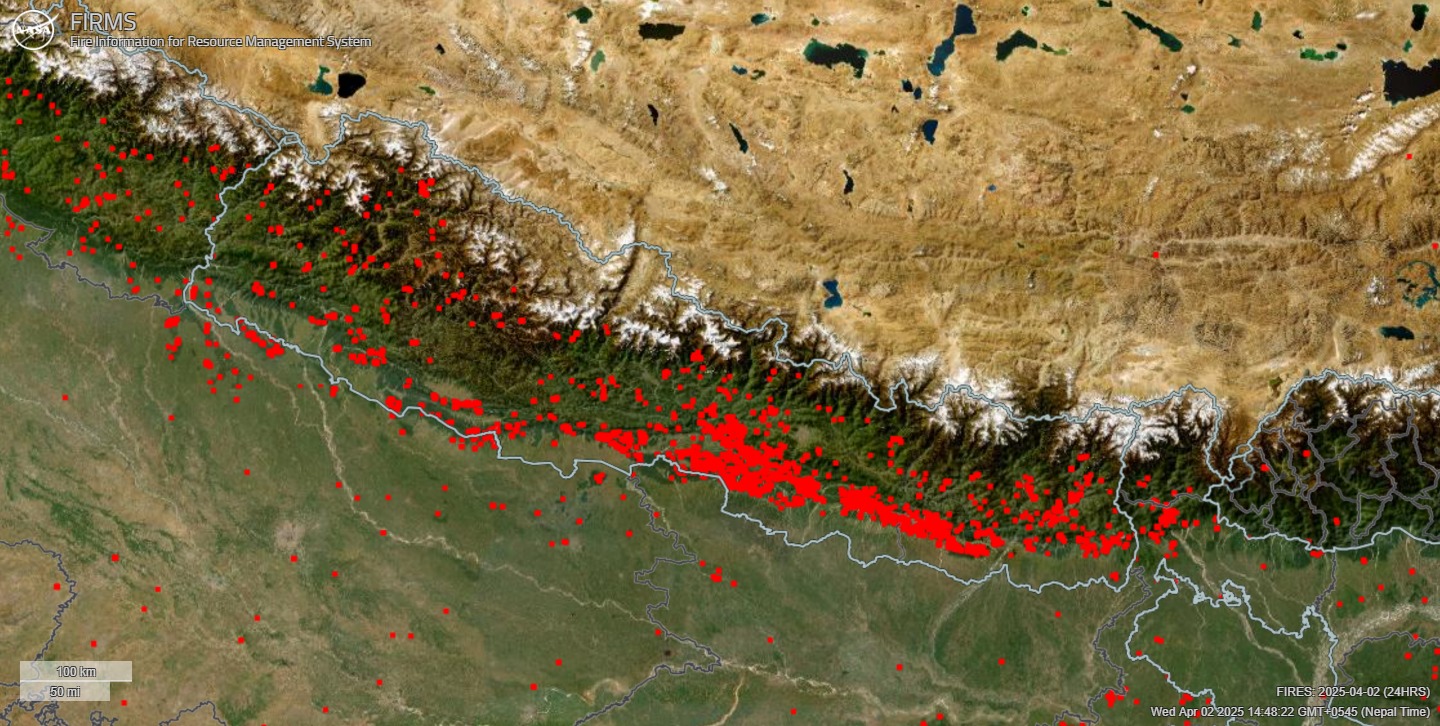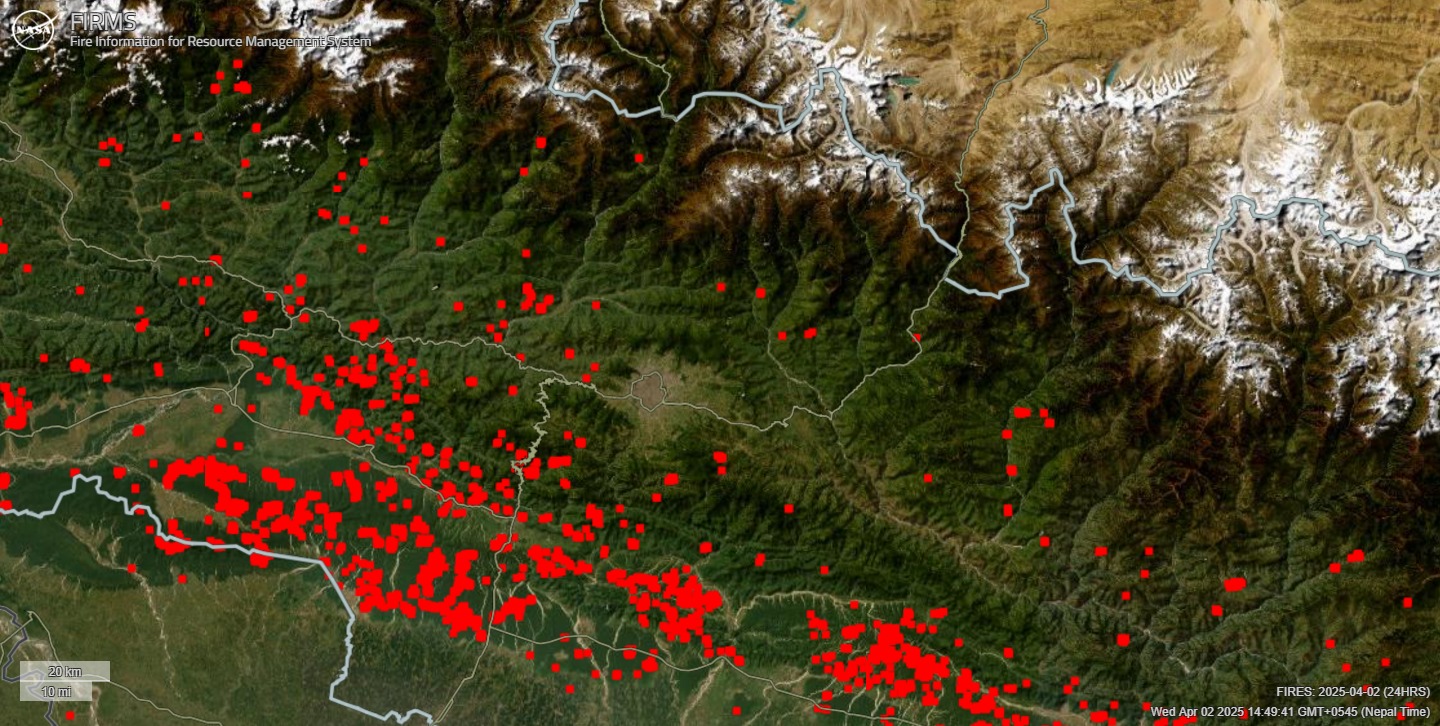
By Prashiddha Ghimire, Intern
Apr 09, 2025
Is Kathmandu a liveable city?
Kathmandu is arguably one of the most popular tourist destinations in South Asia. It has a rich immersive cultural experience to offer, supplemented by an array of scrumptious delicacies and warm hospitality. However, the one facet of Kathmandu that would even trump its touristy reputation is its ambient air pollution. Every now and then, Kathmandu pops up as one of the most polluted cities in the world. As of April 1st, 2025, the US AQI (Air Quality Index) for Kathmandu stands at 150- unhealthy for sensitive people. The particulate matter 2.5 or PM 2.5 is at 55.3 µg/m3, implying that there are 55.3 micrograms of particles of size 2.5 micrometers- 30 times smaller than the width of the human hair- in one cubic meter of air.
I have had many brushes with ambient air pollution, but everything pales in comparison to the one that I had in March of 2021. On 29th March 2021, when I was in the first year of college, something rather strange happened. The sky had become greyish yellow. Gazing at the sky, I thought that there must be a storm on the horizon, the kind I had not experienced before. As I caught up with the news, I realised that it was indeed an impending storm but of a different shape and form- air pollution. As I connected the dots, my senses followed, the air reeked of something burnt, but I went about my day as usual. I did bring this up in one of my classes though yet I treated it very insignificantly. Perhaps, I had not fully grasped the gravity of the situation.

Forest fires incidents throughout the country
As I was about to head home, the Government of Nepal issued a red alert, declaring a four day holiday to all the school and college students. That is when I realised that there was more to it than met the eye. The air pollution level had reached alarming levels across the country, with a recording showing pollutants as high as 281 µg/m3. And why was the pollution sky high? It was because 479 wildfires had been burning the vegetation down to the ground. In nature, wildfires are not anomalies, as they offer plenty of benefits to the biodiversity, from keeping the invasive species out to adding the soil nutrient in check and creating room for the growth of new vegetation. However, in this case, the forest fires had gone out of hand, and wreaked nationwide havoc, with a strong commotion felt in Kathmandu. That is when my mental haze began to clear.
We were given a four day break because the air quality in the valley had reached dangerous levels. All the students may have been exempt from going to classes, but how could they be exempt from breathing the toxic air? This reason for staying home hit hard because you cannot escape poor air, regardless of where you go. At one instance,, the AQI index even showed a record high pollution of 411 µg/m3 at one instance. To understand why Kathmandu’s air was making the city unlivable, I did some deep digging.
 The red points indicate forest fires incidences and you can see the proximity of these fires to the valley
The red points indicate forest fires incidences and you can see the proximity of these fires to the valley
The shape of the Kathmandu valley is bowl-like. This coupled with the elevational gradient, restricted the air flow, limited precipitation, and atmospheric inversions (especially during the winters and early spring), promote the building up of pollutants. Atmospheric or temperature inversions are conditions where cool air pockets are trapped near the surface by warm air pockets, inhibiting pollutant dispersal. Another interesting phenomenon that Nepal grapples with during the dry seasons (May to March) is wildfires, precisely corresponding to this incident. The air pollution in the valley could also be attributed to vehicular emissions, industrial exhausts, open burning of garbage, and transboundary transport of pollutants.
The reality is that regional and international transboundary air pollution are as much a part of the problem as the outdated brick kilns, gas guzzling vehicles, dust suspension, and wildfires are. An international transboundary collaborative approach with India is a need of the hour because the stubble burning in the post monsoon season in the Indo Gangetic Plains of India is transported by the wind towards the valley through river valley channels. Similarly, the transportation sector of Nepal is very polluting and Kathmandu’s topography does not help the case. Even though the government has vested interest in transitioning to a greener vehicular economy, and has backed it with subsidies, the vehicular ecosystem is also constituted largely by petroleum based public vehicles. Will we ever get to ride in electric public vehicles other than the Sajha buses? That’s something up for debate. Another contributory factor to the air pollution is brick kilns, which are by the hundreds in the valley alone. The kilns release particulate matter, such as Total Suspended Particulate Matter (TSPM), PM 2.5, and PM 10, and are a major source of gaseous pollutants such as Sulphur Dioxide (SO2), about 70% of emission in the valley, and Nitrogen Dioxide (NO2), and Carbon Monoxide (CO), as well. All the kilns byproduct reduce the visibility in the valley, while simultaneously adding to the problem of air quality. The government should fasten the push for cleaner kilns technology and uphold stricter regulations.
I stayed home for the four days because I did not want to put my life and health on the line, and to be honest, I had the privilege to do so (stay indoors and limit pollution exposure). As I would sit at home, my mind would be bombarded with several questions. What about the people who did not have the luxury to stay at their homes with their family- people who had to go work outdoors even on such days? What about those brick kiln workers? What are the issues related to air pollution that has not yet come to the forefront? What was the government doing about this because who do we turn to when we do not have the solutions?
As it would turn out, there was a government approved plan formulated by the Ministry of Environment to mitigate, build institutional capacity, and sensitise the citizen to encourage a participatory effort to solve the problem of air pollution over the 5 years, called the Kathmandu Valley Air Quality Management Action Plan 2020 (KVAQMAP). Under this plan, reducing air pollution from vehicular emissions, developing sustainable transportation systems, ensuring environment friendly construction practices, industrial emission reduction, and effective factory, hospital, household, and agricultural waste are some of the focus areas. This plan is primarily focused on managing and reducing local sources of air pollution, and a far cry from the reality.
Apart from the evident health impacts, air pollution also negatively impacts economic productivity negatively. The pollution incurs additional healthcare bills related to illnesses, contributing to productivity loss especially in polluted urban areas. According to a research carried out by Majumder, P., et al. (2024) in India, there is a positive correlation between labour productivity decrease and increase in ambient PM 2.5 concentration. Likewise, in 2015, air pollution contributed to a loss of $ 130 million or 0.6% of the total economic activity (GDP), making 50% of the overall losses of economic outcomes. Additionally, the welfare loss associated with PM 2.5 exposure was found to be around $1,362, making 83% of total welfare losses. These figures paint a grim picture for the future, especially considering we are not yet having such discourses on a large platform in Nepal.
The air pollution issues in Kathmandu goes beyond the realm of public health, as it is linked with environment, tourism, governance, policies, and economy at large. According to a 2021 report by State of Global Air, total air pollution contributed to the death of 48,500 individuals. Similarly, air pollution led to the loss of 2990 years of life expectancy in Nepal. To put things into perspective, air pollution shortens the average lifespan of a Nepali individual by 3 to 5 years . If the pollution persists, would it be safe to assume that we too shall become a part of these statistics?
The efforts to solve air quality issues in Kathmandu, albeit being a half-baked approach that does not delve into the core issue, is somewhat commendable, but what is the status of its implementation? How far has the 5 year plan come ahead in its 5th year? Nobody knows. Every week or so this issue does make some buzz and you will find an article about Kathmandu’s raging air pollution crop up on your feed. Every time it does on my feed, it reminds me of the government's inaction on the issue and where its priorities lie. It gives me flashes of March 2021. In my opinion, the government's climate action should go hand in hand with air pollution control and mitigation as air pollution does not exist in silos. Until this realization strikes and materialises into action, we might have to keep inhaling the polluted air.
Sources:
International Finance Corporation. (2022). Causes and consequences of air pollution in Nepal.
Building Healthy Cities. (2022). Implementation plan: Municipal actions for air quality in the Kathmandu Valley. Arlington, VA: Building Healthy Cities (BHC) project.
https://nepalitimes.com/here-now/bad-air-and-polluted-politics
https://www.stateofglobalair.org/hap/life-expectancy
https://www.stateofglobalair.org/pollution-sources/pm25
https://pmc.ncbi.nlm.nih.gov/articles/PMC6077323/
https://firms.modaps.eosdis.nasa.gov/map/#d:24hrs;@85.45,27.79,9.87z
https://kathmandupost.com/climate-environment/2024/04/10/kathmandu-world-s-most-polluted-city-again
https://iris.who.int/bitstream/handle/10665/345329/9789240034228-eng.pdf?sequence=1
Majumder, P., Chaudhary, E., & Dey, S. (2024). Exposure to ambient PM2.5 and its association with the loss of labor productivity of manufacturing plants in India. Environmental Research Letters, 19(10), 104010.























